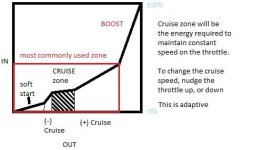oatnet said:
Got mine, thank you Justin!
OK wow, thanks to Adam here for getting the shipments out fast, I wasn't expecting anyone to recieve theirs till this coming week!
Anyways, I just want to make sure people who did receive understand that this is beta and that many firmware upgrades will be happening in the coming 3-5 weeks as we get everything flushed out in preparation for the production release. The firmware that was shipped is V3Beta12 which is functional but has a lot of things still incomplete, and I'll try to list most of it here so people aren't surprised:
1) Battery SOC Gauge: At the moment, the battery fuel gauge has been reverted to being based on the open circuit pack voltage (calculated from V-IR) rather than doing the combination of this plus the accumulated Ah as described in one of my first posts. I'm still working out the best way to implement the algorithm efficiently with the new chip and wasn't ready with this at time of shipping. With LiPoly, LiMn, and SLA this compensated voltage based approach works quite well. Just be sure to input your battery internal resistance by looking at your pack voltage before and after applying full throttle, then use RBatt = (V1 - V2) / A, where V1 is the voltage with no throttle, V2 is the voltage at full throttle, and A is the current limit of the controller. For those with LiFePO4 batteries, you'll have to wait until the full algorithm is implemented before the fuel gauge display works in a meaningful way.
 2) Display Screens:
2) Display Screens: Some of the display screens are anything but 'polished' and are there more for diagnostic purposes during development. This will be obvious as you scroll through them. An ability to select or deselect which screens show up (both while moving and while stationary) is on the agenda.
3) Units: It was pointed out by Telektik that if you select units of miles instead of km, the units text are not necessarily carried through to various setup options. I just haven't got around to that yet, but in your head you can read V/kph as V/mph etc. It doesn't change anything, just the display
4) Initialization: Some things like the accumulated torque for pedal assist mode aren't properly initialized yet on startup, so if you have a PAS torque sensing mode you can see for a few seconds some random human watts on the screen shortly after turning on.
5) PAS Quadrature: I just realized too that the PAS direction input is set only for quadrature PAS encoders. If you have a PAS sensor that only sends one set of pulses, then the CA actually won't pick anything up for your pedal cadence because it will think that every falling edge you are pedaling backwards. In the next firmware there will be a new item in the PAS Direction setup for enabling or disabling quadrature mode
6) Temperature Probe: You have the option of adding a 10K thermistor, a linear temp probe, or no temperature probe. Once a temperature probe is enabled, then the temperature will show up on the first display screen toggling along with the Ah and Dist. It currently shows units as oC, but I will have a oF option listed sooner or later.
7) RShunt: In the calibration menu in high range mode, you can set RShunt up to 9.99 mOhm, rather than just 0.99 mOhm as before. If you do set it above 1mOhm in the high range mode, and then you switch to low range mode, the first digit will be lost. So say 2.36mOhm in high range becomes 23.6 mOhm in low range, which will show up as just 3.6 mOhm, and if you change this to say 1.8 mOhm it will actually change to 21.8, because the 2 was still there just hidden.
I think that's it for the obvious shortcomings. As well, there were some things that were successfully added since I started this post
Ebrake Graphic: If you engage the ebrake levers by shorting the Bk pad to ground, then the throttle slider is replaced with an animated brake handle, to make it super clear why there is no power. As well, when the brake lever is engaged the CA's throttle output goes all the way to 0V, rather than to the min output voltage (which would typically be set to ~0.9V). This is done so that in principle you could use the throttle signal going to 0V in order to activate a regen input on the controller with just a simple comparator circuit, and eliminate the need for a separate wire going to the controller for that.
 V/kph:
V/kph: I added a 'KV' parameter as one of the more advanced throttle control options based on earlier discussions here as a way for the throttle to jump to a value correlating to the current wheel speed before the throttle rate limiting kicks in. However this is not yet implemented, so changing the value has no effect yet.
Ramp Down Rate: There is now a throttle ramp down rate limit, similar to the ramp up rate limit, as requested by Adrian and hopefully useful to a few others too
 View attachment 1
View attachment 1






